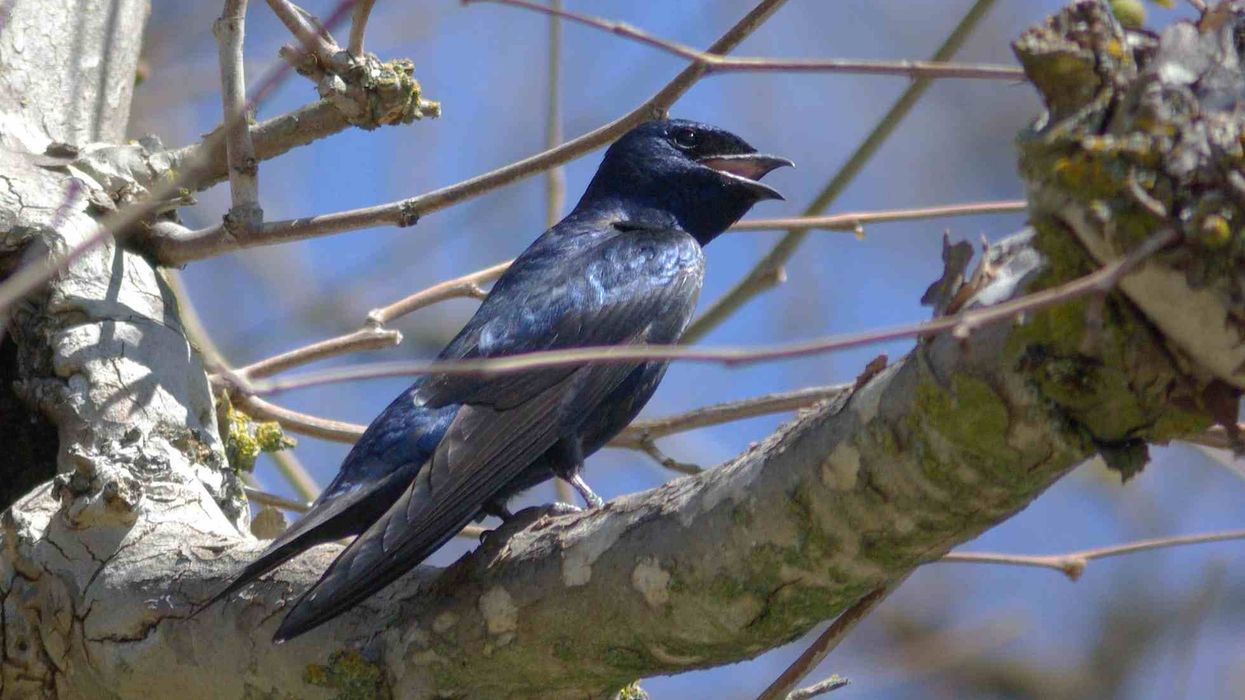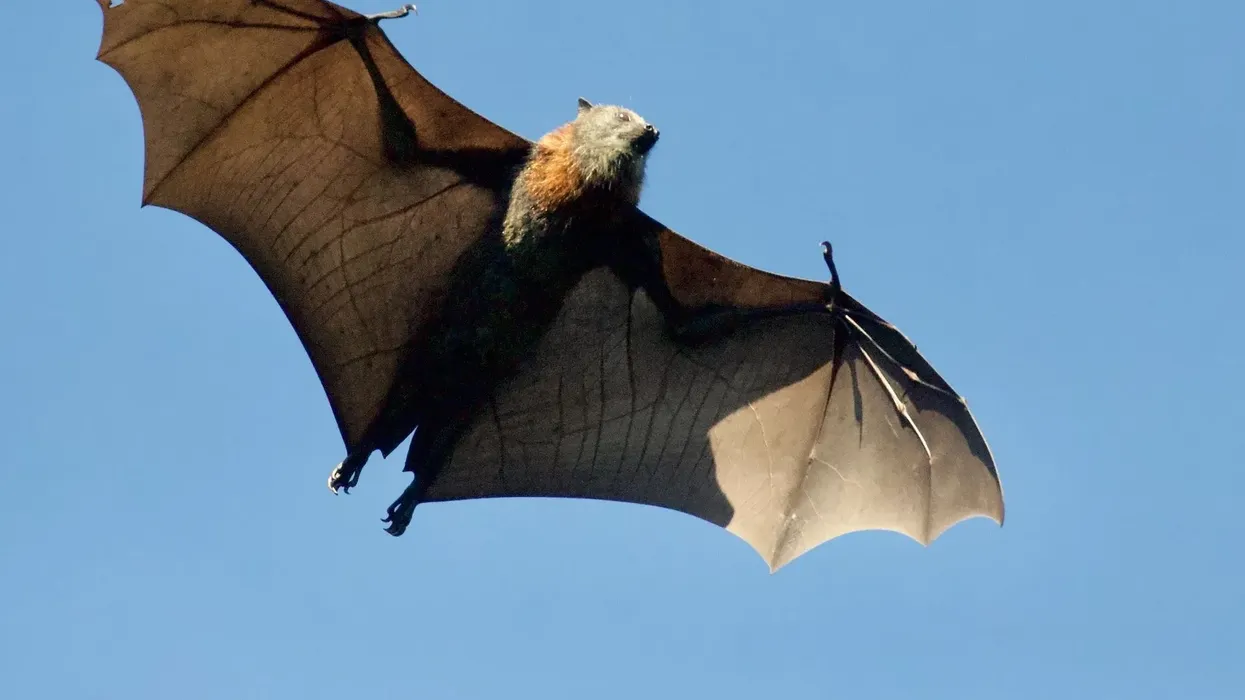The purple martin is the largest of the North American swallows. They are wild, migratory birds that feed mainly on flying insects.
The males of the species have blackish-dark blue and steel blue feathers that refract light giving it a glossy, iridescent purple tint and the name. The female has dark feathers with a blue sheen near the head and underbody. They are fast and adept fliers, usually catching insects in the air.
They forage high above the ground, about 492 ft (150 m), and lead an arboreal lifestyle. Purple martins even drink water while flying by skimming over lakes and collecting water with their lower bills.
Martins are found across temperate and tropical North and South America. They are migratory in nature and travel long distances over land to preferably the same nesting sites year after year if suitable.
Being good pest controllers and songbirds, they are liked by people and have a close association from very old times. They are threatened by house sparrows and European starlings, which compete with them for nest sites and possums, raccoons, squirrels, and snakes, which often raid their nests.
Included in this article are purple martin bird facts, purple martin habitat facts, purple martin conservation efforts, and so on.
If you like this article, why not check out cliff sparrow facts and fox sparrow facts.
Purple Martin Interesting Facts
What type of animal is a purple martin?
The purple martin is a bird of the Passeriformes order. It comes under a group of birds called aerial insectivores- birds that mainly feed on insects by catching them in the air.
What class of animal does a purple martin belong to?
The purple martin belongs to the Aves class, which includes all birds characterized by feathers, toothless jaws, high metabolism, four-chambered hearts, strong and lightweight skeleton, and laying of hard-shelled eggs.
How many purple martins are there in the world?
Purple martins are threatened by climate, insecticides, and habitat loss. They are also threatened by alien species such as house sparrows and European starlings, other predators. Still, the population of the species has remained stable and is classified as of Least Concern. The population of this bird is estimated to be about 7-11 million individuals.
Where does a purple martin live?
Purple martins live across North America, some locations along the west coast, parts of Canada, and countries in central and South America. They prefer temperate and tropical climates and migrate south during winters. They live in grasslands, meadows, shrublands, near open lakes and ponds, swamps, flooded pastures, forest edges, mountain forests, and urban settlements.
What is a purple martin's habitat?
Being aerial insectivores, purple martins thrive well in places with a sizeable insect population. They seldom land on the ground and prefer to catch flying insects on the wing by a technique called hawking.
So, they need open grounds to catch insects in the air and nest sites close by during the breeding season.
They are cavity nesters and build nests in woodpecker holes or hollow man-made structures. So, they can live well in urban settlements near human populations as well as wetlands, swamps, pastures, agricultural lands, and many other habitats that meet these criteria.
Who do purple martins live with?
Purple martins are social birds that live in large flocks but can also live in pairs. The birds can roost together in such big numbers that they appear in weather radar images. The birds usually flock just before the migration south and also in the wintering grounds.
They are considered synanthropic. A synanthropic relationship is where a wild animal lives near or in close proximity to humans and benefits from such association.
Though noisy, the martins are songbirds, and their song is liked by many. People have hung up birdhouses specifically for martins in their gardens and houses. As they eat insects that may feed on crops, they are welcomed by farmers and share a beneficial relationship.
How long does a purple martin live?
The bird can live up to 13 years.
How do they reproduce?
During the breeding season, the males migrate to nest sites and establish a nesting territory that may contain two or three potential nesting locations. The male then attracts the female by songs.
The male and female form a pair, choose one of the nesting locations and build a nest in an existing cavity, usually woodpecker holes. The nest is built in three levels.
The first level consists of mud, bigger twigs, and stones, the second consists of finer twigs, and the third level consist of finer grass and leaves. The nest may have a mud rim to prevent the eggs from rolling over.
In eastern North America, the birds prefer man-made structures, usually nest boxes to natural cavities. When built-in woodpecker holes, the nests may be far apart.
But in nest boxes, the nests are close together, forming a colony. The females incubate the eggs for 15-18 days, and both parents feed the chicks. The young birds leave the nest in 26-31 days from hatching.
What is their conservation status?
Though the numbers have declined due to various factors, the population of the species is stable and is categorized as Least Concern.
Purple Martin Fun Facts
What do purple martins look like?

Purple martins, contrary to their names, are not purple in color. The adult males of the species have blackish-blue, dark, or bright blue feathers and have an iridescent sheen caused by the refraction of light, which gives them a purplish tint.
In some lighting, they also appear to be green. They are small in size, about 8 in (20 cm) long with a wingspan of about 16 in (41 cm), and have a small forked tail.
The birds of this species are sexually dimorphic, meaning the male and female have different characteristics. Though the male is colored, the female has dark blackish-brown feathers, a pale underbody with dark blue feathers near the head.
How cute are they?
These North American birds are small, agile, and fast, with dark blue feathers, which have an iridescent sheen that varies in color, the purple martin looks very cute.
How do they communicate?
Purple martins are quite noisy. They can communicate through various calls and songs. The male emits boisterous chirping to attract a mate.
The martin chirps, croaks, rattles, chortles, and even make clicking sounds by snapping its bills. The loudest vocalization is of the male at dawn. Called the pre-dawn song, it is considered to attract other martins to the nesting colony or warn interlopers.
How big is a purple martin?
Purple martins are about 8 in (20 cm) long and weigh up to 2.1 oz (60 g).
Though the biggest of the swallows, they are only about twice the size of the smallest of the species and are as big as a house sparrow.
How fast can a purple martin fly?
These North American birds are excellent fliers. They spend most of their lives flying, eating, and even drinking in the air.
They fly in a quick flapping and gliding pattern and finally dive with tucked wings while landing on a perch. They catch insects using a technique called hawking and can perform incredible acrobatics while pursuing their prey. They can fly at a speed of up to 40 mph (64 kph).
How much does a purple martin weigh?
Purple martins weigh 1.6-2.1 oz (45-60 g).
What are the male and female names of the species?
The males are called roosters, and the females are called hens.
What would you call a baby purple martin?
A baby purple martin is called a chick.
What do they eat?
Purple martins eat a variety of flying insects like bees, wasps, winged ants, bugs, flies (like house flies, or crane flies), beetles, butterflies, moths, dragonflies, grasshoppers, some spiders, fire ants, and gnats. Contrary to popular beliefs, these birds do not eat mosquitoes.
Are they aggressive?
Purple martins are gentle birds and are aggressively attacked by other birds for nesting sites. During the breeding season, they may defend their territory from other martins. During nesting, they can be aggressive toward birds of prey, even earning them the name Subis, which in Latin means a bird that breaks eagles’ eggs.
Would they make a good pet?
Purple martins are wild migratory birds and need a lot of open space for hunting, mating, and living. They also need a habitat that has a lot of insects that they can feed on.
So, they don’t make for good pets. In most places, the bird is protected under the Migratory Bird Treaty Act, which makes it illegal to capture or harm the bird.
But people can hang a martin house in their gardens to provide nesting sites for the birds in their homes and gardens. You can expect them to visit these houses maximum till August to September, especially in northern areas.
Did you know...
The name of the genus of this bird, Progne refers to Procne, a girl from Greek mythology. As per the myth, Procne was the elder daughter of the king of Athens, Pandion, and the wife of King Tereus of Thrace.
After avenging her husband for a misdeed, she prayed to gods to turn her into a swallow to escape her husband's wrath.
What are purple martins good for?
Purple martins are great songbirds and pest controllers. They can eat up to 400 insects a day which makes them a great friend of farmers. For this reason, the native Americans attracted these birds to their fields using nest boxes, sharing a symbiotic relationship.
Do purple martins mate for life?
Purple martins are monogamous, but both males and females of the species are highly promiscuous. Once a pair is formed, they collectively defend a nest from intruders and interlopers.
Here at Kidadl, we have carefully created lots of interesting family-friendly animal facts for everyone to discover! Learn more about some other birds from western tanager facts and swallow facts pages.
You can even occupy yourself at home by coloring in one of our free printable Purple Martin coloring pages.










